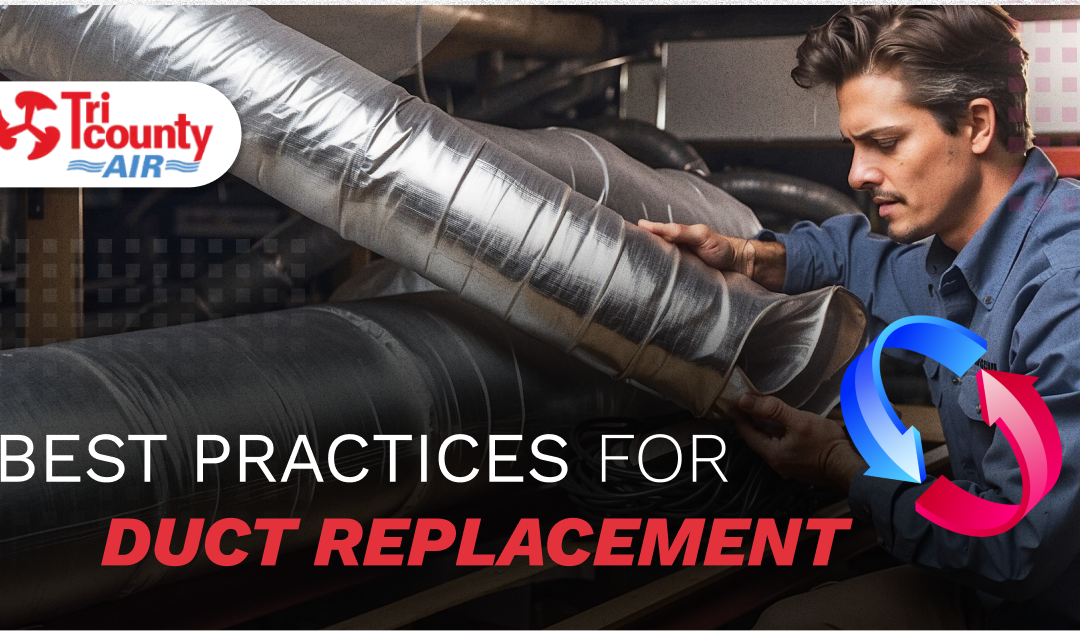When replacing the ductwork in your attic and other parts of your home, an HVAC contractor will follow numerous best practices to ensure comfort and efficiency for many years. Ductwork installation and replacement is much more complex than many people think. Any mistakes can lead to costly delays and reduce heating and cooling system performance. When performing duct replacement, here are some best practices Tri County Air’s trained professionals follow:
1. Correct Placement of Ducts
The location of ducts and how far they travel are important ductwork design considerations. If a duct travels too far to a specific room, it may be too warm or too cold. It’s best to find the shortest route with the fewest turns. Also, avoid exposing ducts to the elements; they should be protected from extreme temperatures by placing them behind walls and ceilings (or under floors).
2. Proper Duct Sizing
Finding the right-sized ducts is an essential part of duct replacement. If a duct is too small, it will restrict airflow, but if it’s too large, lower air velocity will make it harder for the system to distribute heated or cooled air. Determining the correct duct size requires a contractor to go room by room to calculate the required heating or cooling load.
3. Select the Best Material
The best material depends on your heating and cooling needs and budget. A professional will most likely select from the following materials:
- Sheet Metal: Galvanized steel or aluminum is strong and durable but hard to insulate.
- Insulated Fiberglass: It is convenient for cutting and sealing but breaks down more easily.
- Plastic, Polyester, or PVC: These non-metallic materials are flexible, simplifying installation, but can tear if poorly installed or stressed.
Your HVAC technician will help explore options that include industry-approved materials.
4. Insulate Air Ducts
Ducts in a garage, attic, or other unconditioned space should be wrapped in insulation to minimize heat and energy loss. Reputable contractors are familiar with the most effective types of insulation and how to ensure your duct system is efficient.
5. Duct Sealing
Proper sealing is a duct replacement best practice that can save significantly on energy costs. Leaky ducts waste energy due to air loss, which causes your HVAC unit to work harder. They can also cause poor indoor air quality. To seal ducts, technicians use:
- Screws to secure duct sections
- Air leakage tests to find leaky seams
- Fiberglass mesh and mastic to seal joints and seams
- Fewer connecting components
- Longer sections of duct whenever possible
6. Size All Filters Equally
Larger HVAC systems may have multiple air filters. For example, you can install a filter at each room vent. But filtration components elsewhere in your duct system are equally important. To maintain efficiency, every filter should be equally sized and selected. This requires performing room-by-room calculations and matching filters with your system, which a trained technician can help with.
7. Balance the Airflow
Air balancing means neutral airflow is maintained in your HVAC system. Supply and return ducts should have the same airflow capacity and the appropriate number of registers. Therefore, conditioned air is evenly distributed throughout your home, so each room receives the right amount of heating or cooling.
Air balancing can:
- Improve Comfort: Most people spend the majority of their time indoors, so an optimal comfort level is important for your well-being.
- Increase Your HVAC System’s Lifespan: Optimal airflow helps your HVAC system run more smoothly and reduces wear and tear.
- Improve Indoor Air Quality: Poor airflow can lead to conditions that enable mold to form, which can release harmful toxins.
- Increase Energy Efficiency: Air balancing reduces the amount of energy your HVAC system needs to function and maintain the desired temperature.
- Reduce Costs: Wasting energy means spending more on energy bills due to poor airflow and having to adjust the thermostat more frequently, which causes your HVAC unit to work harder.
Call Tri County Air for Help with Duct Replacement
Tri County Air specializes in duct replacement and attic insulation. We also provide a range of other HVAC services in Charlotte, Manatee, and Sarasota Counties. Ductwork is the largest part of your HVAC system and is responsible for distributing air to every part of your home. Despite its importance, it’s often overlooked. Replacing ductwork and following the best practices listed above, can address many problems and improve comfort, indoor air quality, and energy efficiency.
Does your home need duct replacement? To schedule an in-home assessment, load calculation, and estimate, request an appointment online or call (941) 485-2222.

